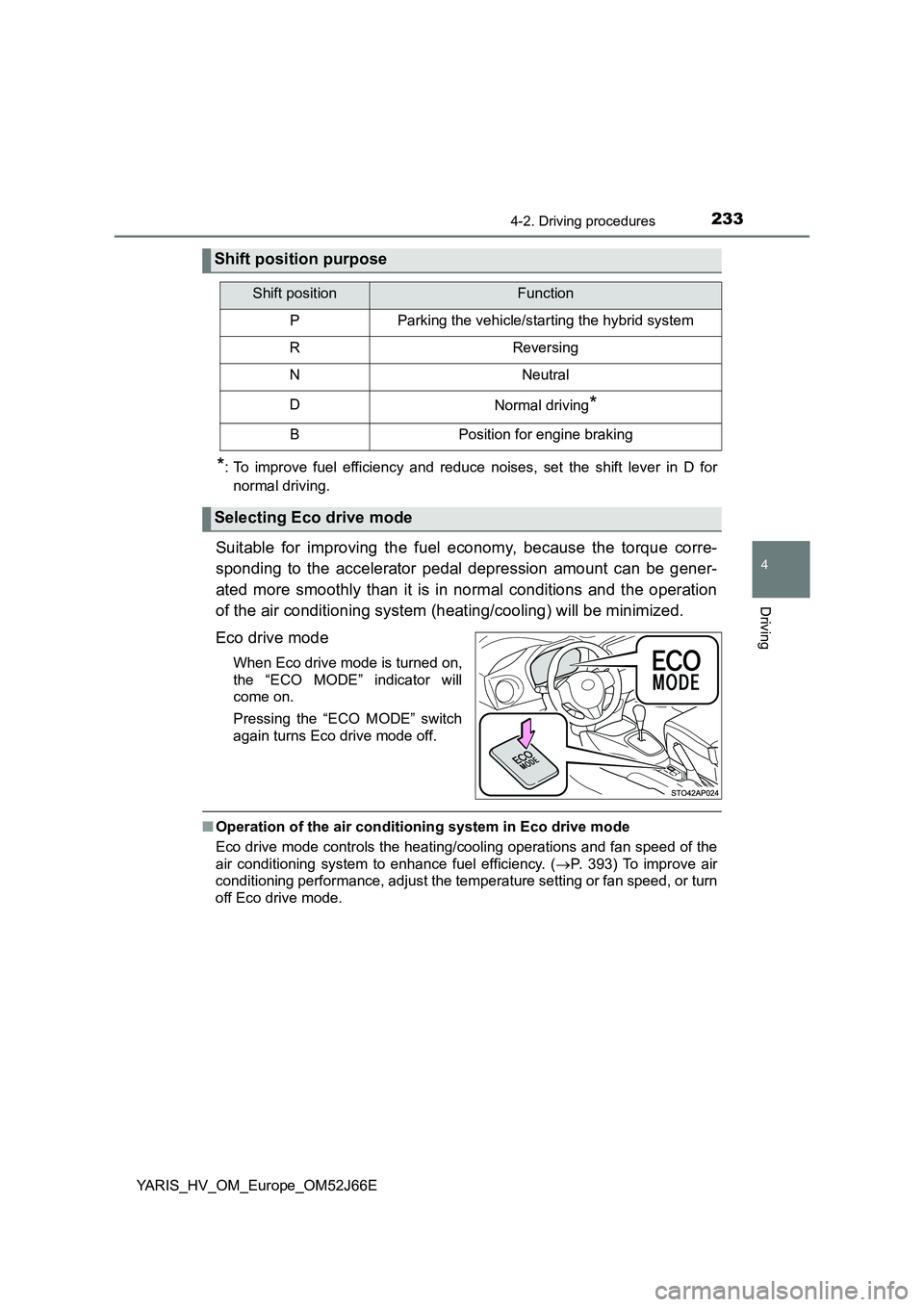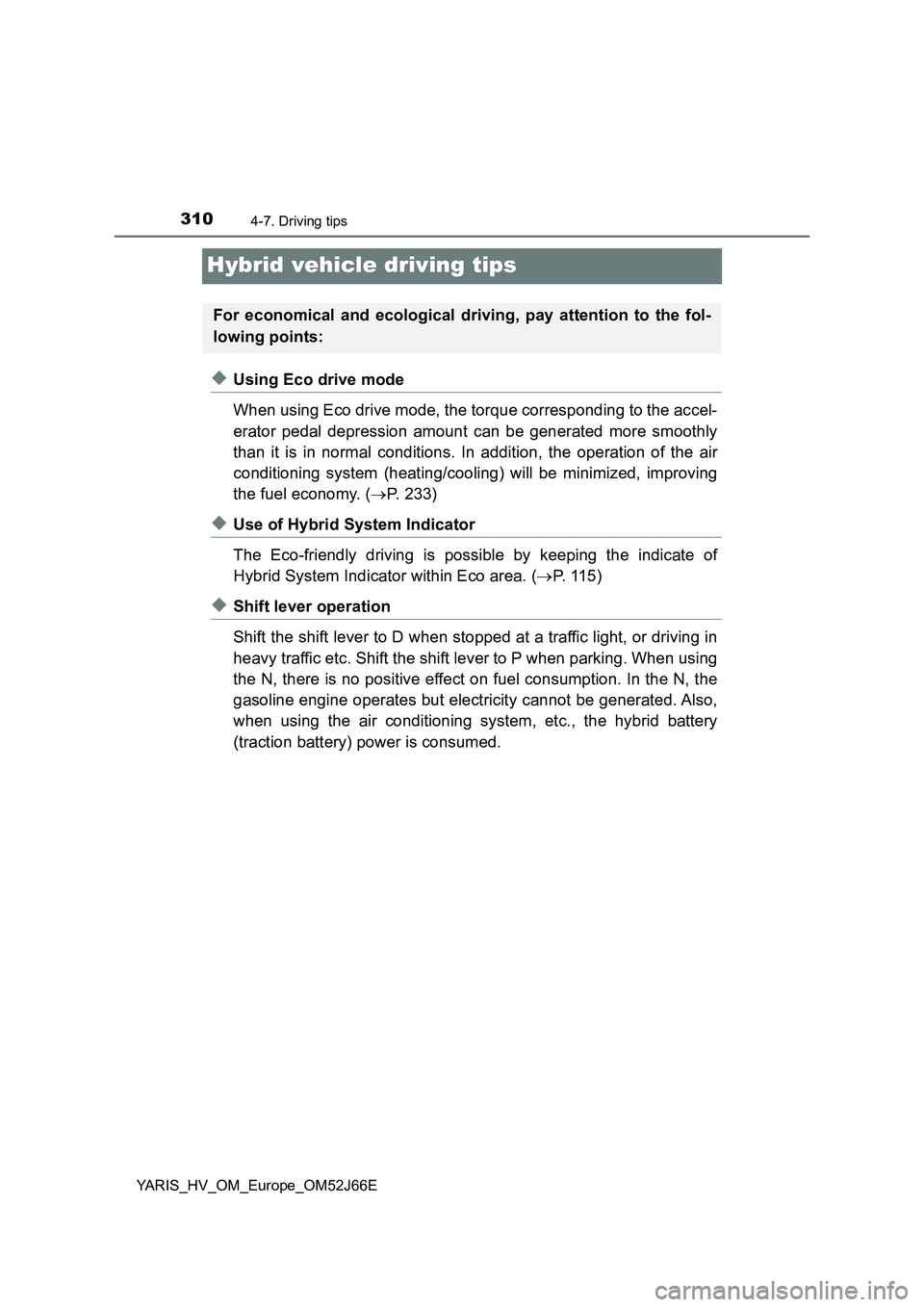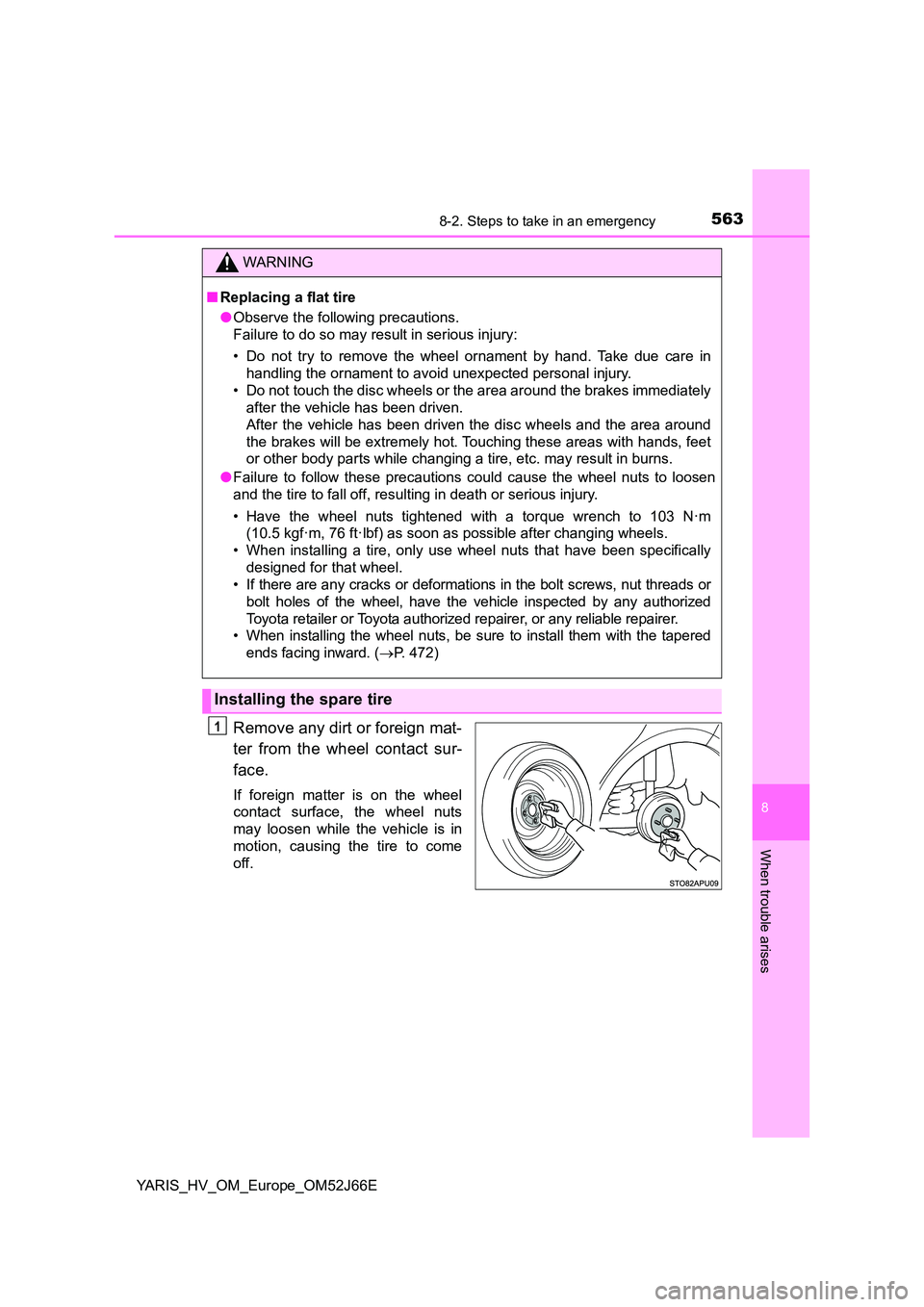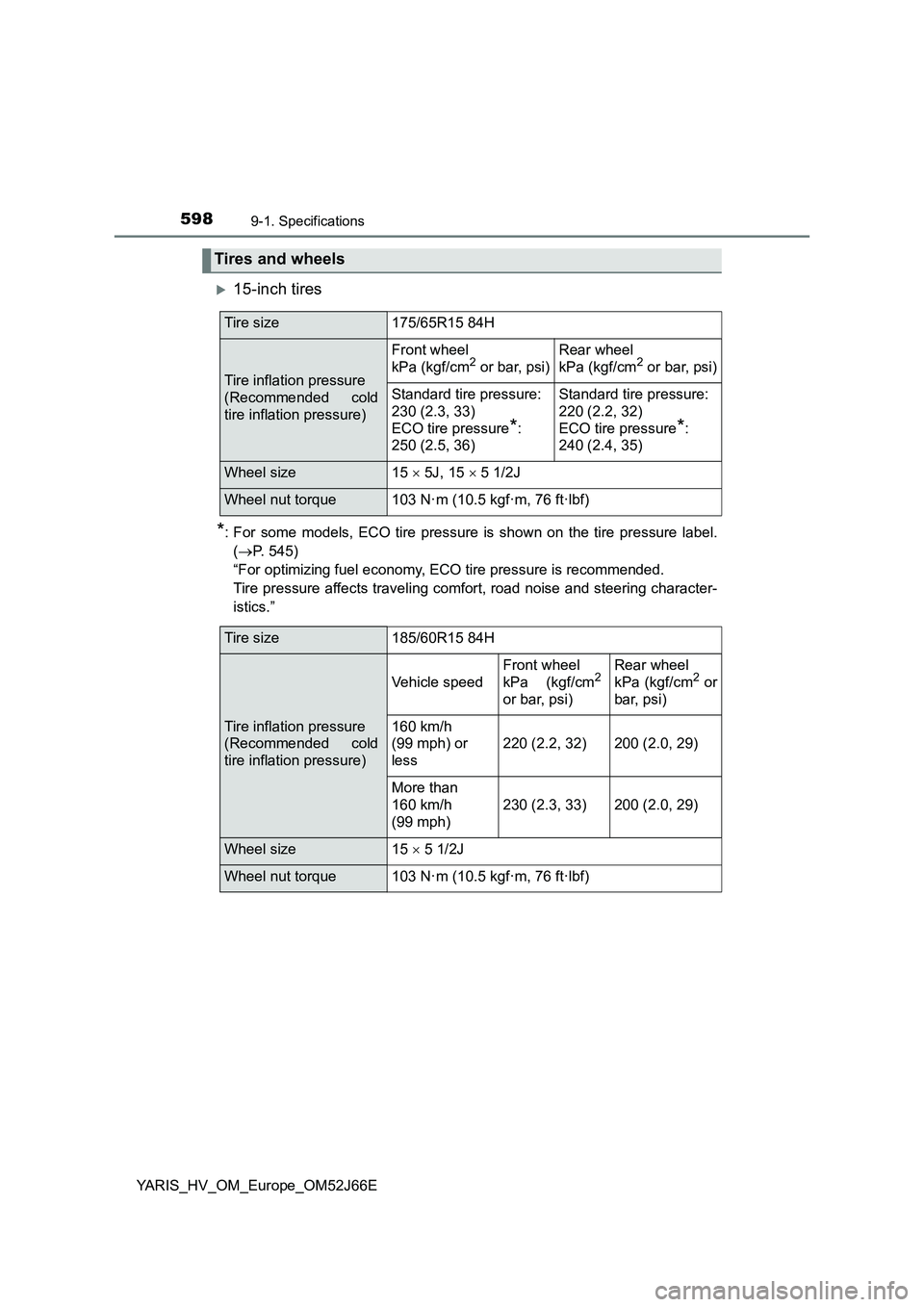Page 233 of 632

2334-2. Driving procedures
4
Driving
YARIS_HV_OM_Europe_OM52J66E
*: To improve fuel efficiency and reduce noises, set the shift lever in D for
normal driving.
Suitable for improving the fuel economy, because the torque corre-
sponding to the accelerator pedal depression amount can be gener-
ated more smoothly than it is in normal conditions and the operation
of the air conditioning system (heating/cooling) will be minimized.
Eco drive mode
When Eco drive mode is turned on,
the “ECO MODE” indicator will
come on.
Pressing the “ECO MODE” switch
again turns Eco drive mode off.
■ Operation of the air conditioning system in Eco drive mode
Eco drive mode controls the heating/cooling operations and fan speed of the
air conditioning system to enhance fuel efficiency. ( P. 393) To improve air
conditioning performance, adjust the temper ature setting or fan speed, or turn
off Eco drive mode.
Shift position purpose
Shift positionFunction
PParking the vehicle/starting the hybrid system
RReversing
NNeutral
DNormal driving*
BPosition for engine braking
Selecting Eco drive mode
Page 310 of 632

3104-7. Driving tips
YARIS_HV_OM_Europe_OM52J66E
Hybrid vehicle driving tips
◆Using Eco drive mode
When using Eco drive mode, the torque corresponding to the accel-
erator pedal depression amount can be generated more smoothly
than it is in normal conditions. In addition, the operation of the air
conditioning system (heating/cooling) will be minimized, improving
the fuel economy. ( P. 233)
◆Use of Hybrid System Indicator
The Eco-friendly driving is possible by keeping the indicate of
Hybrid System Indicator within Eco area. ( P. 115)
◆Shift lever operation
Shift the shift lever to D when stopped at a traffic light, or driving in
heavy traffic etc. Shift the shift lever to P when parking. When using
the N, there is no positive effect on fuel consumption. In the N, the
gasoline engine operates but electricity cannot be generated. Also,
when using the air conditioning system, etc., the hybrid battery
(traction battery) power is consumed.
For economical and ecological driving, pay attention to the fol-
lowing points:
Page 563 of 632

5638-2. Steps to take in an emergency
8
When trouble arises
YARIS_HV_OM_Europe_OM52J66E
Remove any dirt or foreign mat-
ter from the wheel contact sur-
face.
If foreign matter is on the wheel
contact surface, the wheel nuts
may loosen while the vehicle is in
motion, causing the tire to come
off.
WARNING
■ Replacing a flat tire
● Observe the following precautions.
Failure to do so may result in serious injury:
• Do not try to remove the wheel ornament by hand. Take due care in
handling the ornament to avoid unexpected personal injury.
• Do not touch the disc wheels or the area around the brakes immediately
after the vehicle has been driven.
After the vehicle has been driven the disc wheels and the area around
the brakes will be extremely hot. Touching these areas with hands, feet
or other body parts while changing a tire, etc. may result in burns.
● Failure to follow these precautions could cause the wheel nuts to loosen
and the tire to fall off, resulting in death or serious injury.
• Have the wheel nuts tightened with a torque wrench to 103 N·m
(10.5 kgf·m, 76 ft·lbf) as soon as possible after changing wheels.
• When installing a tire, only use wheel nuts that have been specifically
designed for that wheel.
• If there are any cracks or deformations in the bolt screws, nut threads or
bolt holes of the wheel, have the vehicle inspected by any authorized
Toyota retailer or Toyota authorized repairer, or any reliable repairer.
• When installing the wheel nuts, be sure to install them with the tapered
ends facing inward. ( P. 4 7 2 )
Installing the spare tire
1
Page 565 of 632
5658-2. Steps to take in an emergency
8
When trouble arises
YARIS_HV_OM_Europe_OM52J66E
Lower the vehicle.
Firmly tighten each wheel nut
two or three times in the order
shown in the illustration.
Tightening torque:
103 N·m (10.5 kgf·m, 76 ft·lbf)
Do not use other tools or any addi-
tional leverage other than your
hands, such as a hammer, pipe or
your foot.
Vehicles with steel wheels (except vehicles with tire pressure warn-
ing system or compact spare tire)
Reinstall the wheel ornament.
Align the cutout of the wheel orna-
ment with the valve stem as
shown.
3
4
5
Page 592 of 632
5929-1. Specifications
YARIS_HV_OM_Europe_OM52J66E
Engine
Model1NZ-FXE
Ty p e4-cylinder in line, 4-cycle, gasoline
Bore and stroke75.0 84.7 mm (2.95 3.33 in.)
Displacement1497 cm3 (91.3 cu.in.)
Valve clearance
(engine cold)
Intake: 0.15 0.25 mm (0.0060.010 in.)
Exhaust: 0.25 0.35 mm (0.010 0.014 in.)
Fuel
Fuel type
When you find these types of fuel label at the
gas station, use only the fuel with one of the fol-
lowing labels.
EU area:
Unleaded gasoline conforming to European
standard EN228 only
Except EU area:
Unleaded gasoline only
Research Octane
Number95 or higher
Fuel tank capacity
(Reference)36 L (9.5 gal., 7.9 Imp.gal.)
Electric motor (Traction motor)
Ty p ePermanent magnet motor
Maximum output45 kW
Maximum torque169 N·m (17.2 kgf·m, 125 ft·lbf)
Page 598 of 632

5989-1. Specifications
YARIS_HV_OM_Europe_OM52J66E
15-inch tires
*: For some models, ECO tire pressure is shown on the tire pressure label.
( P. 545)
“For optimizing fuel economy, ECO tire pressure is recommended.
Tire pressure affects traveling comfort, road noise and steering character-
istics.”
Tires and wheels
Tire size175/65R15 84H
Tire inflation pressure
(Recommended cold
tire inflation pressure)
Front wheel
kPa (kgf/cm2 or bar, psi)
Rear wheel
kPa (kgf/cm2 or bar, psi)
Standard tire pressure:
230 (2.3, 33)
ECO tire pressure*:
250 (2.5, 36)
Standard tire pressure:
220 (2.2, 32)
ECO tire pressure*:
240 (2.4, 35)
Wheel size15 5J, 15 5 1/2J
Wheel nut torque103 N·m (10.5 kgf·m, 76 ft·lbf)
Tire size185/60R15 84H
Tire inflation pressure
(Recommended cold
tire inflation pressure)
Vehicle speed
Front wheel
kPa (kgf/cm2
or bar, psi)
Rear wheel
kPa (kgf/cm2 or
bar, psi)
160 km/h
(99 mph) or
less
220 (2.2, 32)200 (2.0, 29)
More than
160 km/h
(99 mph)
230 (2.3, 33)200 (2.0, 29)
Wheel size15 5 1/2J
Wheel nut torque103 N·m (10.5 kgf·m, 76 ft·lbf)
Page 599 of 632
5999-1. Specifications
9
Vehicle specifications
YARIS_HV_OM_Europe_OM52J66E
16-inch tires
Compact spare tires
Tire size195/50R16 84V
Tire inflation pressure
(Recommended cold
tire inflation pressure)
Vehicle speed
Front wheel
kPa (kgf/cm2
or bar, psi)
Rear wheel
kPa (kgf/cm2 or
bar, psi)
160 km/h
(99 mph) or
less
220 (2.2, 32)200 (2.0, 29)
More than
160 km/h
(99 mph)
240 (2.4, 35)210 (2.1, 30)
Wheel size16 6J
Wheel nut torque103 N·m (10.5 kgf·m, 76 ft·lbf)
Tire sizeT125/70D16 96M
Tire inflation pressure
(Recommended cold
tire inflation pressure)
420 kPa (4.2 kgf/cm2 or bar, 60 psi)
Wheel size16 4T
Wheel nut torque103 N·m (10.5 kgf·m, 76 ft·lbf)